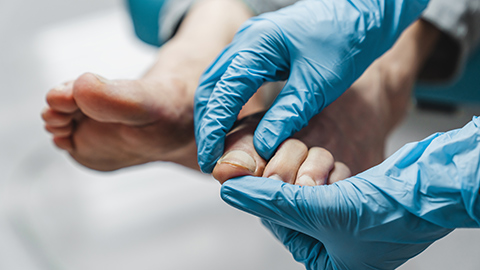
A client is struggling with plantar fasciitis. They call a local massage therapist with the right kind of expertise, but reveal they are concerned about their toenail fungus and the risk it could spread.
How concerning is this risk? Is it possible to spread toenail fungus to other areas of the body. Could it spread to other people? We explore those questions on this episode of “I Have a Client Who . . .”
Resources: 
Pocket Pathology: /abmp-pocket-pathology-app
digger.jpg (223×272) (no date). Available at: https://lastrow.files.wordpress.com/2009/10/digger.jpg (Accessed: 29 March 2023).
Fungal Nail Infections | Fungal Diseases | CDC (2022). Available at: https://www.cdc.gov/fungal/nail-infections.html (Accessed: 29 March 2023).


0:00:01.4 Ruth Werner: Hello, I Have a Client Who... Listeners, Ruth Werner here. And I'm so excited to let you know that my library of online self-paced continuing education courses has just expanded. I now have a two-hour ethics course called A Doctor's Note is Not Good Enough, and What is Better? This NCBTMB-approved course goes into why a doctor's permission or approval or even a prescription doesn't provide the legal or safety protection you might think it does. Then we look at how to start useful conversations with healthcare providers that will actually get us to safe and effective massage for our clients with complex conditions. Visit my website at ruthwerner.com for more information and to register for A Doctor's Note is Not Good Enough and What is Better?
[music]
0:01:00.0 RW: Hi, and welcome to I Have a Client Who... Pathology conversations with Ruth Werner, the podcast where I will discuss your real-life stories about clients with conditions that are perplexing or confusing. I'm Ruth Werner, author of A Massage Therapist's Guide to Pathology, and I have spent decades studying, writing about and teaching about where massage therapy intersects with diseases and conditions that might limit our client's health.
0:01:29.4 RW: We almost always have something good to offer even with our most challenged clients, but we need to figure out a way to do that safely, effectively, and within our scope of practice. And sometimes, as we have all learned, that is harder than it looks. Today's I Have a Client Who... Story comes from a very dear friend, who I haven't had the chance to see in several years, so I was especially pleased when they first sent me an email and then we communicated in the old-fashioned way, we had an actual phone call in real-time. And it was so much fun. And the story took a couple of interesting turns, but ultimately the question at the centre of it is fairly simple.
0:02:13.6 RW: My friend's style of work derives from Rolfing and structural integration. And their client found them and they'd had an introductory conversation, but they actually have not yet met in person. What came up in this conversation is that the client is struggling with plantar fasciitis, and that is well within the wheelhouse for my friend and their style of work. But the interesting twist was that this client reported that they have toenail fungus, and they were so, so concerned about the possibility of it spreading. So they spent a lot of time in this introductory phone call, not talking about their plantar fasciitis, which is a fascinating condition with lots and lots of contributing factors and possible strategies to get it better, but that's not our topic today, because their conversation really focused on the risk of spreading their toenail Fungus.
0:03:05.2 RW: Now, this massage therapist has never seen this client's feet, and all we know is that this person reports they have this toenail fungus on one toe and their sister has it on the same toe. And the client was willing to wear a sock during the massage and happy for the massage therapists to wear gloves or to do both of those things all to reduce the risk of this fungus spreading. Whether they were concerned about the fungus spreading to other areas on their own feet or if they were worried about this fungus spreading to the massage therapist, is an open question. Frankly, it doesn't really matter that much. Now, this massage therapist is not new to our field, they have seen a lot of toenail fungus over their years, they have never had a client voice this much concern about it spreading.
0:03:55.5 RW: So they reached out to me to see if maybe they'd been missing some really important information about foot fungus with all of the many clients they have seen before who live with this chronic issue. And I have to agree, I also have seen my fair share of athlete's foot and toenail fungus, and I've never heard anyone be this deeply concerned about its spread. So let's explore this just a bit. First, I have a really fun little factoid about athlete's foot, which is a fungal infection that could involve a few different species of fungi that just really seem to love the environment of the skin between the toes, especially the third and fourth toe, but it often spreads from there. And here's my little factoid, before World War I, athlete's foot, what was unheard of in North America. We had never seen it before.
0:04:44.2 RW: But when soldiers came home from Europe after the Great War, they brought with them some new passengers; the fungi that cause athlete's foot, and now this is the most common fungal infection in this country. These fungi thrive in environments that are warm and moist, sort of like the inside of an often-worn shoe. And this is one reason this fungal infection can be so stubborn, people will treat the skin on their feet, but they may forget to treat the insides of their shoes, so they just keep getting exposed over and over again. People who have athlete's foot, who handle their feet a lot, are also vulnerable to having that fungus spread to their hands. Athlete's foot, when it's just on the skin, is treatable with a variety of fungicides.
0:05:34.7 RW: My brother had it when we were growing up, and I will forever associate the smell of Fast Actin' Tinactin with his teenage years. You may have heard of other possible remedies for athlete's foot like tea tree oil or even peeing on your feet while you're in the shower. I have no particular opinion on these, except it seems like that would sting if there are any open blisters between the toes. There are a few other things we can say about athlete's foot. The main issue I'd like to leave you with before we move on to talk about toenails is that this fungal infection can often be really itchy and it can create weepy open blisters between the toes, and of course, any time we have compromised skin, we have a risk of secondary infection. So athlete's foot can sometimes be the starting place for a much more serious foot and leg problem, especially for people who have any kind of immune system compromise or slow and sluggish circulation.
0:06:33.4 RW: One other very quick point, athlete's foot does not always appear between the toes. There is a form of fungal infection of the foot that can appear in other locations and it looks just like dry skin, but treating it with moisturizer does not make it go away, and it does run the risk of spreading to other areas. So it's important to pay attention to this. Now, let's talk about toenails. Under certain circumstances, some of those fungi that really love that warm moist environment, like the inside of a shoe, can find their way under a toenail. And if a colony gets set up in the nail bed, it is no longer treatable with topical fungicides or tea tree oil or pee or what have you. I even found a site that claimed a Vicks VapoRub would cure this, it doesn't. Toenail fungus is fiendishly hard to get rid of.
0:07:31.1 RW: I remember in the 1980s, we had just developed some oral medications that could eradicate fungus growing under the nails. And there was an aggressive marketing campaign involving this horrible little character named Digger who would lift up a toenail and dive underneath, and this made you wanna run out and buy this medication right away. And the medication was really effective, that's true, but it also turned out to be bad for your liver. And people treating their mild toenail fungus were developing liver injuries, so the aggressive marketing has now subsided and we only recommend these oral medications when the toenail fungus is causing pain or deformity of the foot or in some other way limiting this person's quality of life. Other treatment options are limited, they basically involve removing the nail entirely.
0:08:23.7 RW: And any time you hear the words surgery and foot in the same sentence, you can predict a long and slow healing period. So why would a person be vulnerable to a fungal nail infection, to begin with? Some factors might include foot trauma, diabetes, poor circulation and immune system compromise, but probably the most common situation is if they have some kind of mild nail injury or foot deformity, so that their nails are frequently irritated by their footwear. Things like hammer toe or claw toe or mallet toe might make them more prone to this. And of course, that made me think about how this might affect the way this person walks and maybe that could be a contributor to their plantar fasciitis and so on because of course, everything connects to everything.
0:09:18.3 RW: Toenail fungus is incredibly common. The CDC site suggests that up to 14% of the population has it. This client seems to feel like they have something really dangerous, or likely to spread, but truly with basic hygiene, this is very unlikely. I would recommend that they make sure their nail isn't irritated by their footwear and to treat their footwear with anti-fungal meds and to be careful about things like going barefoot in public settings where fungi might be lurking. And what should we do when we see signs of athlete's foot or toenail fungus in our workspace? Do you need to cancel the appointment? Can you just cover it? Maybe cover your hands too? What really are the risks? I'm so glad you asked. The short answer is this because we wash our hands after every client, the risk of our developing a new fungal infection from touching our client's feet is slim to none.
0:10:15.0 RW: If this talk makes you wanna add another 10 seconds to your hand-washing rituals, I will consider that a win, but there are some cautions. First, athlete's foot often causes itching and blisters, and of course, these are at very least a local contraindication for massage. Also, although we are unlikely to develop a new fungal infection, we are in fact able to spread these fungi over our clients' bodies to other areas on the same foot or to the other foot, all together, and this is probably something they will not thank us for. That said, if the infection is under the nails and not on exposed skin, this is much less of an issue. So should this client keep their sock on while they get treatment for their plantar fasciitis? Frankly, I don't think that's necessary unless they are really uncomfortable without it.
0:11:11.1 RW: Are there options? They could wear a finger cot over the affected toe, or the therapist could wear gloves, tight-fitting nitrile gloves are hypoallergenic and allow practically the same kind of sensitivity as skin-to-skin contact, and this would allow the massage therapists to work with the whole foot, which is definitely part of this person's approach for plantar fasciitis. I'm gonna guess that this strategy about athlete's food and toenail fungus, which is that we don't touch open wounds directly, and we're cautious about spreading athlete's foot further on the affected foot or to the other side, these are strategies you already use. If not, I recommend that you start and if yes, I'm happy to validate that you are on the right track.
0:11:58.8 RW: Hey everybody, thanks for listening to I Have a Client Who... Pathology conversations with Ruth Werner. Remember, you can send me your I Have a Client Who... Stories to ihaveaclientwho@abmp.com, that's Ihaveaclientwho all one word, all lowercase @abmp.com. I can't wait to see what you send me and I'll see you next time.